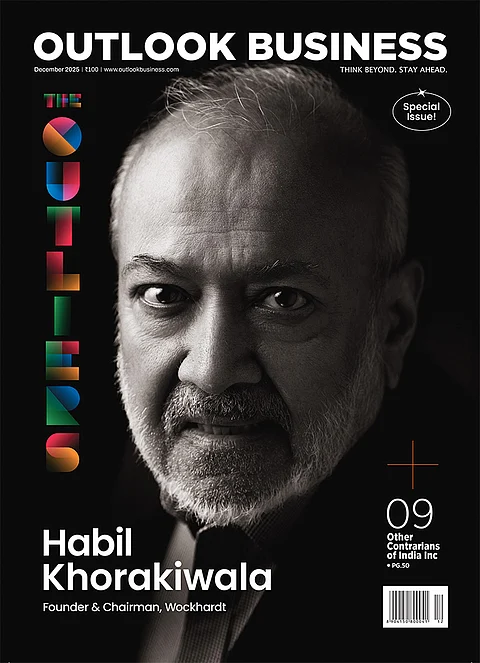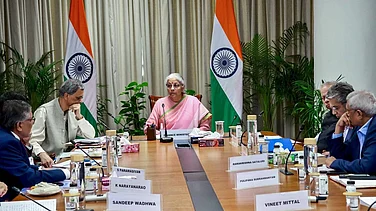
India’s exports share stagnates at 2%; needs a targeted diversification strategy.
US tariffs, global competition intensify; India must prioritise product- and geography-specific plans.
Immediate policy support and focus on cost-efficiency essential for long-term competitiveness.
While diversification makes sense strategically, India needs to have a specific product- and geography-wise game plan for diversification of its exports, says Sonal Varma, India chief economist at Japanese financial firm Nomura.
Varma points out that India’s share in global exports has hovered around 2% for years, showing little improvement even during periods when global supply chains were shifting away from China. Now, as higher US tariffs hit most major exporting nations, almost every country is seeking new markets—making the race for diversification fiercer than ever.
In this conversation with Outlook Business, Varma discusses how India’s diversification journey has evolved, why the current tariff wave presents both risks and opportunities, what strategic focus areas the country must prioritise to stay competitive on the global stage and and why a targeted product- and market-level strategy will be key to sustaining export growth. Edited excerpt:
How do you assess India’s diversification efforts historically, even before the current tariff discussions began?
There are two aspects here. One is India’s market share in global exports across product categories, and the second is the effort to diversify into newer markets. Diversification can mean expanding within existing markets or increasing market share by tapping new ones.
India’s share in global exports is around 2%, and this figure has remained relatively constant for many years. If you look at product-wise data, we’ve seen some increase in India’s share of global exports of electronics, but in most other sectors it has either stagnated or declined slightly.
Globally, in categories where supply chains are moving away from China—such as textiles—the benefits have largely gone to countries like Bangladesh, Vietnam and Cambodia. India’s share in global textile exports hasn’t really increased during this period. The same holds across several product categories.
The auto sector has done relatively better, with growing exports to some African and Latin American markets. But overall, both in terms of India’s share in global exports and diversification into new markets, there’s still considerable scope for improvement.
Between 2017 and 2024, India’s export share with its top six trading partners declined in four cases and rose only with the US and the Netherlands. What could explain this limited diversification?
To understand that, it’s important to note two key things. First, the US—our largest export market—is closing up, so India needs to offset that by diversifying exports. But high US tariffs are affecting many countries, not just India. So now, several countries are trying to diversify simultaneously.
That means competition outside the US is extremely high. This is very different from the last seven or eight years when third-country competition was relatively limited. Now, with rising US tariffs, competition has intensified—especially with China’s emergence as a dominant player in many of these alternative markets.
So while diversification makes sense strategically, we need to be very clear about which markets and which product categories we focus on. For instance, in the EV space, China is dominant, but in small cars, demand is growing in Africa and parts of Latin America. Those markets—with similar consumption patterns to India—might make more sense than, say, ASEAN countries, where Chinese competition is already intense.
Similarly, for electronics, most of India’s recent export growth has come from increased shipments to the US, even as we’re trying to diversify away from it. So we need a clear game plan by product and geography.
Given the 50% US tariff shock, how quickly can India’s labour-intensive sectors realistically redirect exports to alternative markets?
Realistically, diversification takes time. Building new supplier relationships can take years because they’re based on trust, consistency, and ecosystem development. Even in the current high-tariff environment, many exporters would prefer to ride it out rather than break established relationships. They might cut prices or take a margin hit to maintain those supplier ties, assuming tariffs will eventually come down.
Diversification—setting up new supply chains, bases, and buyer relationships—can easily take over a year. In the short term, particularly in sectors like textiles where India now faces 50% tariffs compared to competitors at around 20%, exporters are effectively priced out. The immediate result will be heavy profit margin compression. Over time, diversification could help, but it’s not an overnight shift.
And remember, India isn’t the only country diversifying. Vietnam, for example, is also targeting the EU textile market and is highly competitive. So for Indian exporters, the challenge in labour-intensive sectors is significant.
What could be the near-term economic impact of these tariffs?
India’s exports to the US account for about 2.2% of GDP, and roughly 60% of those exports are subject to the 50% tariff. The impact depends on how much of that tariff burden exporters can pass on to US customers. If they pass it on, export volumes could decline. If they absorb it, profit margins will take a big hit.
Each exporter will decide based on its cash flow and demand sensitivity. Our rough estimate is that if US tariffs remain elevated for a full year, India’s GDP growth could be reduced by 0.6 to 0.8 percentage points.
That’s the direct effect. Indirectly, exporters’ investment plans could slow, and workers in those industries might face salary stagnation or even job losses. So the overall GDP impact, including indirect effects, could be up to 0.8 percentage points.
What kind of microeconomic risks does this pose for India this year or next?
The biggest risk is to MSMEs in export-heavy sectors like textiles, jewellery, and marine products. As cash flows shrink, many could struggle to service working capital loans, leading to higher non-performing assets for banks with exposure to these sectors.
We could also see a slowdown in capex from these smaller manufacturers, which would affect overall fixed investment. Job uncertainty or income stagnation among workers could further dampen consumption.
Larger exporters can usually weather this because they have stronger balance sheets or alternative credit lines, but MSMEs are far more vulnerable. Prolonged tariffs will widen the gap between big and small firms.
Given this stress, what kind of financial or policy support should the government prioritise?
Policy support needs to operate at two levels—immediate and medium-term.
In the short term, the focus should be on working capital support for exporters whose profit margins and cash flows are under strain. This could take the form of government-guaranteed loans through the banking system, similar to what was done during COVID for MSMEs. The idea is to ensure these firms survive, pay their workers, and avoid shutting down.
In the medium term, diversification is important, but it must go hand in hand with competitiveness. Merely identifying new markets isn’t enough—products must be globally competitive in terms of cost and quality. Many countries are becoming more protectionists, and the global trade “pie” is shrinking. India has to compete for a smaller share.
So, policies that make Indian exports cost-efficient and high quality—like developing domestic supply chains for components in electronics—are crucial. Bringing such production within India can cut costs and make our products more competitive.
India’s competitiveness has often been questioned. What are the key bottlenecks exporters face when scaling to new markets?
It’s not that all Indian products are uncompetitive. In sectors like pharmaceuticals and auto components, India has done quite well globally, including on quality. Smartphones are another recent success story.
But in lower value-added manufacturing—footwear, leather goods, textiles—we’ve struggled. These are highly cost-sensitive sectors that depend heavily on economies of scale and consistent quality. India often lacks that scale, partly because of rigid labour laws that encourage smaller manufacturing setups.
Broadly, issues under the “ease of doing business” umbrella—labour regulations, logistics, infrastructure—play a role. To benefit from supply-chain shifts away from China in toys, textiles, leather or furniture, India must focus on producing at scale, maintaining quality, and keeping prices competitive. All three are essential.
Indian-made cotton towels are quite popular in Europe. It’s interesting how that niche has endured for years
Absolutely. Some of those towels are of excellent quality—they’re not cheap products. They’re actually premium, high-priced goods. It’s a good example of a segment India has maintained leadership in.
Even as we often talk about manufacturing exports, but agriculture and food exports deserve equal focus. With the right packaging, cold storage, and logistics infrastructure, India could do much more in this area. Food processing could be a major growth driver for India’s exports.



























